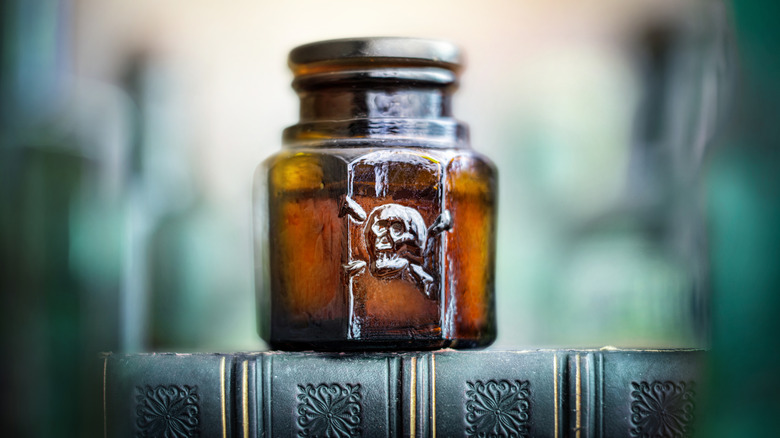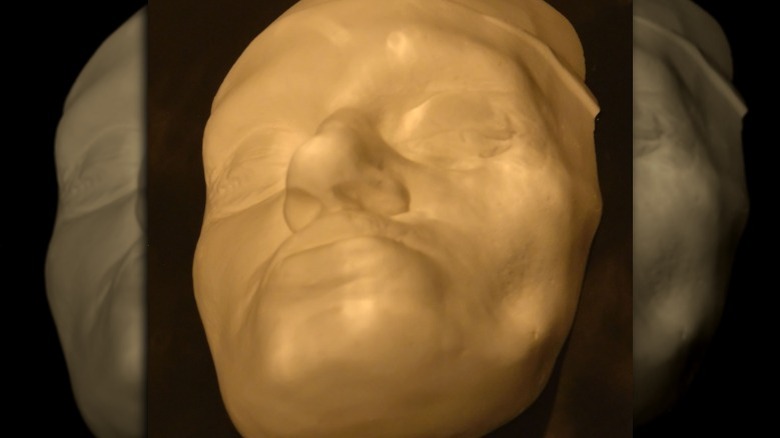Things You Didn't Know About Serial Killer Gesche Gottfried
The quirks that twist the mind into the cruel, dark places from which serial killers are born are almost uniquely male. In fact, according to Psychology Today , around 85% of serial murderers have been male. That's an astonishingly high percentage, but this isn't a boys-only game in the least. Maybe there are more female killers out there and they're just better at avoiding authorities. One thing is for sure though, they do exist, and they're some of the most dangerous serial killers in history.
Gesche Gottfried is one of these twisted women whose story has been mostly overshadowed but make no mistake, Gottfried was the real deal long before Jeffrey Dahmer or Ted Bundy were even born. She was a tailor's daughter, born in Germany in the late-18th-century, per the Byline Times. She enjoyed singing and dancing and had aspirations of one day joining the theater — but she also had a husband who didn't support those dreams. But overall, she seemed like any normal woman of her age at first glance. You know, until that unsupportive husband of hers died a most terrible death. Even then, she just seemed like an unlucky person. But was she really that unfavored by fate? Of course not. Time has shone a light on her heinous deeds and now we know all the dark details.
Many of her victims were close to her heart
Serial killers aren't usually as prolific as they appear on television or in movies. It's safe to say though, that any killer who leaves a body count in the double digits is certainly prolific by any standard. According to the Scandinavian Journal of Forensic Science, Gesche Gottfried falls into that category.
It's estimated that Gottfried killed at least 16 victims while she was active, and many of them had one striking similarity: They were people close to her. The first to die was her husband, who was the out-all-night type who reportedly treated Gottfried poorly. Next, were her mother, father, and her three children because she wanted to marry a man her parents didn't approve of and the man didn't want to raise her kids. She wasn't done. Once she got pregnant by the new man in her life and when he tried to leave her, she offed him as well. She also killed her twin brother who showed up on her doorstep out of a job.
There was a pause in her killings until she got married again and subsequently killed her new husband. After accepting a marriage proposal from a neighbor, she made quick work of him too. Sometime later, she killed the woman of a family that took her in, and this one proved to be her downfall.
She was the last person to be publicly beheaded in Bremen
After the wife and mother of the family had been killed, the man of the house began to grow suspicious. According to the Scandinavian Journal of Forensic Science, the man began to notice strange white grains in his food. He refused to eat anything Gesche Gottfried made him and got the grains tested. It was arsenic.
Gottfried was arrested and tried for the murder of multiple people. In total, she was convicted of 16 slayings, but during one of her interviews, she'd said she was certain she'd killed "at least 30." Now, the death penalty was still alive and well in these times leading to this killer's trial, and there was no chance she'd get off easy. Not only was her number of victims outrageous, she'd murdered her own family. Gottfried was sentenced to death by beheading and, as Atlas Obscura points out, she was the last prisoner to be publicly killed in the city of Bremen, Germany.
The town came out to witness her death, which took place on her birthday — ouch. The executioner severed her head, leaving townsfolk sick, and her remains were sent in two directions. Her body went to the local hospital's department of pathology while her head was put on display at the Domhof Museum where they charged admission for viewing it and donated the money to an orphanage.
Poison was her murder weapon
Serial killer Gesche Gottfried's murder weapon of choice was arsenic, specifically, a solution of arsenic known as "Mäusebutter," or "mouse butter" in English, which is a mixture of arsenic and animal fat. The Hollywood Reporter's review of 2020's "Effigy: Poison and the City," a film inspired by Gottfried's murder run, says this was used to kill rodents and other bothersome animals. Killing with poison was effective for this murderer, but it's also one of the most cliché ways a female serial killer can commit murder, not because most female murderers use poison as a weapon of choice but because people seem to think they do.
You've likely heard poison called "a woman's murder weapon" at some point in your life, and some people hold strongly to this, but it's really not the weapon used most by female killers. According to The Washington Post, men commit almost all of their murders with guns while women only commit half of their murders with guns, but because firearms as such a preferred weapon for men, anything other than shooting becomes more of a murder weapon for women. Guns are still in the lead, but women also use knives and blunt objects more often than poison. In fact, poison is only sixth on the list, and as Quartz mentions, it's likely they only use poison because their killing behaviors are different than that of male murderers.
Her motive still isn't known
Most serial killers have some sort of motive. They might kill to fulfill some twisted sexual desire or need for control, or they may kill in their conquest to amass wealth, which is often women serial killer's primary motivation, per Psychology Today. But in the case of Gesche Gottfried, according to Atlas Obscura, nobody's been able to pin down a solid motive in the two centuries since her death.
Her motive is debated, but the most common guess seems to be that she suffered from Munchausen Syndrome by proxy. This specific mental illness, as detailed by University of Michigan Health, causes those in a caregiver role to lie about symptoms of injury or disease in someone they care for or, at times, harm those under their care to create the symptoms or illness. That would mean Gottfried had only been trying to get those close to her to remain sick so she could care for them, which doesn't seem to be the case. Some of her victims, as the Scandinavian Journal of Forensic Science points out, were random. She also seemed to kill those when she had a reason to punish them, such as her husbands, or if it brought her a perceived gain. Remember how she killed her children when she wanted to marry a man who didn't want kids? That doesn't really fit in with the scope of the disease. Maybe she just liked killing.
The townsfolk "honored" her with a memorial in the town square
People get honored for the darndest things, don't they? Most get celebrated for doing things that are worth celebrating but not for Gesche Gottfried. She got the opposite.
In the town of Bremen, you'll find a single large black stone among the smaller granite stones in the cathedral square. This is one of few "spitting stones" in all of Germany, and according to the Bremen town website, it was put there on behalf of Gottfried after her death. Yes, it is exactly as it sounds. Today, the stone is used for its intended purpose, meaning people who visit the town can let it fly, spitting on the stone to show their disgust toward the serial killer and her heinous deeds.
It really seems like the Germans have it right. Instead of venerating the twisted individuals who kill for pleasure or to fulfill some sick drive, they "honor" them by letting those filled with disgust insult their names long after their deaths. And sure, there's nothing wrong with finding the dark parts of humanity interesting, but a spitting stone is way cooler than a Netflix deal.





